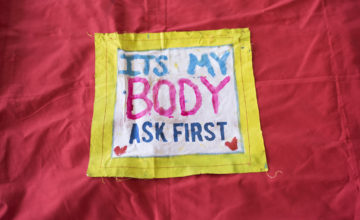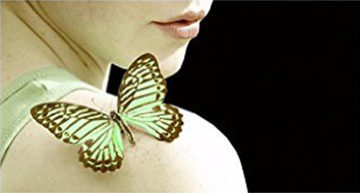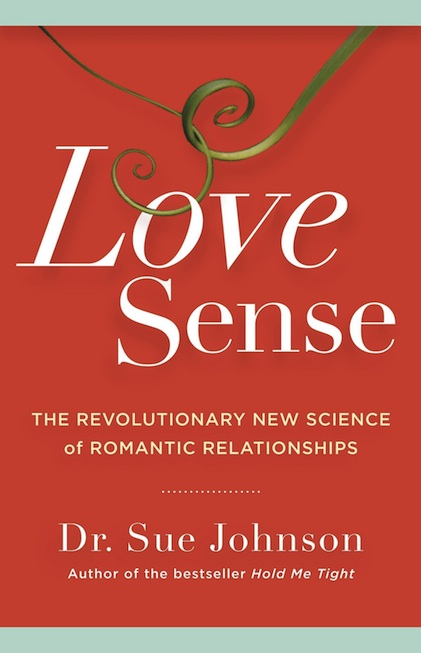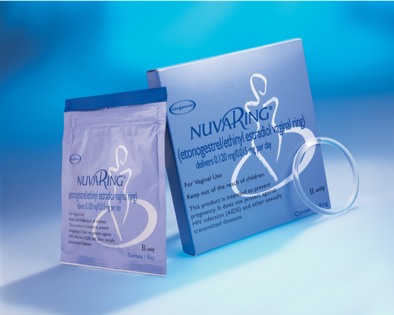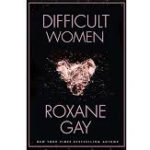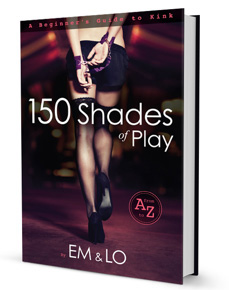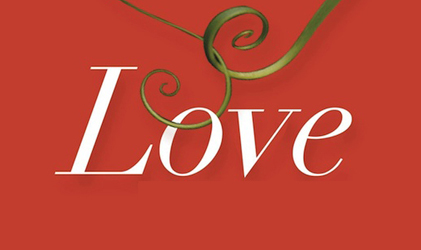
The new book Love Sense by clinical psychologist Dr. Sue Johnson tries to take some of the mystery out of that big emotion. While that may not sound very romantic, Johnson is dedicated to the scientific exploration of love so that we may have better, more-fulfilling, more intimate long-term relationships — especially in a world where independence, isolation and non-monogamy are growing more common. Her book offers real-life examples and practical exercises, based on the Emotionally Focused Therapy she developed in her own practice. Below is an excerpt from the first chapter, which outlines a brief history of love and why it still matters in the 21st century.
“Love Sense” by Dr. Sue Johnson
from Chapter 1
My memories are full of the sounds and sights of love: The ache in my elderly grandmother’s voice when she spoke of her husband, gone nearly fifty years. A railway signalman, he had courted her, a ladies’ maid, for seven years on the one Sunday she had off each month. He died of pneumonia on Christmas Day after eighteen years of marriage, when he was forty-five and she just forty.
My small enraged mother flying across the kitchen floor at my father, a former naval engineer in World War II, who stood large and strong in the doorway, drinking her in with his eyes, and she, seeing me, stopping suddenly and fleeing from the room. She left him after three decades of slammed doors and raised fists when I was ten. “Why do they fight all the time?” I asked my granny. “Because they love each other, sweetie,” she said. “And watching them, it’s clear that none of us knows what the hell that means.” I remember thinking, “Well, I won’t do this love thing, then.” But I did.
Telling my first great love, “I refuse to play this ridiculous game. It’s like falling off a cliff.” Weeping just months into a marriage, asking myself, “Why do I no longer love this man? I can’t even pinpoint what is missing.” Another man smiling quietly at me, and I, just as quietly, leaning back and letting myself plunge into the abyss. There was nothing missing.
Sitting, years later, watching the last of the ice finally melting on our lake one morning in early April and hearing my husband and children walking through the woods behind me. They were laughing and talking, and I touched for a moment the deepest joy, the kind of joy that was, and still is, entirely enough to fill up my heart for this lifetime.
Anguish and drama, elation and satisfaction. About what? For what?
***
Love can begin in a thousand ways—with a glance, a stare, a whisper or smile, a compliment, or an insult. It continues with caresses and kisses, or maybe frowns and fights. It ends with silence and sadness, frustration and rage, tears, and even, sometimes, joy and laughter. It can last just hours or days, or endure through years and beyond death. It is something we look for, or it finds us. It can be our salvation or our ruin. Its presence exalts us, and its loss or absence desolates us.
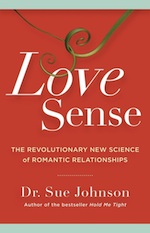 We hunger for love, yearn for it, are impelled to it, but we haven’t truly understood it. We have given it a name, acknowledged its force, cataloged its splendors and sorrows. But still we are confronted with so many puzzles: What does it mean to love, to have a loving relationship? Why do we pursue love? What makes love stop? What makes it persist? Does love make any sense at all?
We hunger for love, yearn for it, are impelled to it, but we haven’t truly understood it. We have given it a name, acknowledged its force, cataloged its splendors and sorrows. But still we are confronted with so many puzzles: What does it mean to love, to have a loving relationship? Why do we pursue love? What makes love stop? What makes it persist? Does love make any sense at all?
Down through the ages, love has been a mystery that has eluded everyone—philosophers, moralists, writers, scientists, and lovers alike. The Greeks, for instance, identified four kinds of love, but their definitions, confusingly, overlap. Eros was the name given to passionate love, which might or might not involve sexual attraction and desire. In our day, we are equally bewildered. Google reported that the top “What is” search in Canada in 2012 was “What is love?” Said Aaron Brindle, a spokesman for Google. “This tells us about not only the popular topic for that year…but also the human condition.” Another website, CanYouDefineLove.com, solicits definitions and experiences from folks around the globe. Scroll through the responses and you’ll agree with the site’s founders that “there are just as many unique definitions as there are people in the world.”
Scientists try to be more specific. For example, psychologist Robert Sternberg of Oklahoma State University describes love as a mixture of three components: intimacy, passion, and commitment. Yes, but that doesn’t solve the riddle. Evolutionary biologists, meanwhile, explain love as nature’s reproductive strategy. In the grand abstract scheme of existence, this makes sense. But for illuminating the nature of love in our everyday lives, it’s useless. The most popular definition is perhaps that love is…a mystery! For those of us—and that is almost all of us—who are trying to find it or mend it or keep it, this definition is a disaster. It robs us of hope.
Does it even matter whether we understand love?
If you had asked that question as recently as thirty or forty years ago, most of the world would have said, “Not really.” Love, despite its power, wasn’t considered essential to daily life. It was seen as something apart, a diversion, even a luxury, and oftentimes a dangerous one at that (remember Romeo and Juliet and Abelard and Heloise?). What mattered was what was necessary to survive. You tied your life to your family and your community; they provided food, shelter, and protection. Since the earliest conception of marriage, it was understood that when you joined your life to another’s, it was for eminently practical reasons, not emotional ones: to better your lot, to acquire power and wealth, to produce heirs to inherit titles and property, to create children to help with the farm, and to care for you in your old age.
Even as life eased for growing numbers of people, marriage remained very much a rational bargain. In 1838, well into the Industrial Revolution, naturalist Charles Darwin made lists of the pros and cons of marriage before finally proposing to his cousin Emma Wedgwood. In favor, he noted, “Children…Constant companion, (& friend in old age)…object to be beloved & played with…better than a dog anyhow…a nice soft wife on a sofa with good fire, & books & music…These things good for one’s health.” Against it, he wrote, “perhaps quarreling—Loss of time.—cannot read in the Evenings…Anxiety & responsibility—less money for books &c…I never should know French,—or see the Continent—or go to America, or go up in a Balloon, or take solitary trip in Wales—poor slave.”
We don’t have Emma’s list, but for most women the top reason to marry was financial security. Lacking access to schooling or jobs, women faced lives of punishing poverty if they remained unwed, a truth that continued well into the 20th century. Even as women gained education and the ability to support themselves, love didn’t figure too highly in choosing a mate. When asked in 1939 to rank eighteen characteristics of a future spouse or relationship, women put love fifth. Even in the 1950s, love hadn’t made it to first place.
I am reminded of my aunt, who, when she found out that I had a “man in my life,” advised me, “Just make sure he has a suit, dear”—code for “Make certain he has a steady job.”
In the 1970s, however, love began heading the list in surveys of what American women and men look for in a mate. And by the 1990s, with vast numbers of women in the workforce, marriage in the Western world had completely shifted from an economic enterprise to, as sociologist Anthony Giddens calls it, an “emotional enterprise.” In a 2001 U.S. poll, 80 percent of women in their twenties said that having a man who could talk about his feelings was more important than having one who could make a good living. Today, both men and women routinely give love as the main reason to wed. And indeed, this is increasingly the case around the world; whenever people are free of financial and other shackles, they select a spouse for love. For the first time in human history, feelings of affection and emotional connection have become the sole basis on which we choose and commit to a partner. These feelings are now the primary basis for the most crucial building block of any society, the family unit.
A love relationship is now not only the most intimate of adult relationships, it is also often the principal one. And for many it is the only one. The American Sociological Review reports that since the mid-1980s, the number of Americans saying that they have only their partner to confide in has risen by 50 percent. We live in an era of growing emotional isolation and impersonal relationships. More and more, we dwell far from caring parents, siblings, friends, and the supportive communities we grew up in. And more and more we live alone. According to the latest U.S. census, more than thirty million Americans live solo, compared with just four million in 1950. We toil for longer hours and at more remote locations requiring lengthy commutes. We communicate by e-mailing and texting. We deal with automated voices on the telephone, watch concerts performed by holograms of deceased artists (such as rapper Tupac Shakur), and soon we will be seeking assistance from holographic personnel. At New York City–area airports, travelers were recently introduced to six-foot-tall, information-spouting AVA, short for airport virtual assistant, or avatar.
Loneliness researcher John Cacioppo, a psychologist at the University of Chicago, contends that in Western societies, “social connection has been demoted from a necessity to an incidental.” As a result, our partners have been forced to fill the void. They serve as lover, family, friend, village, and community. And emotional connection is the only glue in this vital, unique relationship.
So yes, understanding the nature of love absolutely does matter. Indeed, it is imperative. Continued ignorance is no longer an option. Defining love as a mystery beyond our grasp and control is as toxic to the human species as is poison in our water. We must learn to shape our love relationships. And now, for the first time, we can, thanks to an unheralded revolution in the social and natural sciences that has been under way for the past twenty years.
from “Love Sense” by Sue Johnson, available on Amazon.com
Copyright (c) 2013 by Sue Johnson. Reprinted with permission of Little, Brown and Company. All rights reserved.
Tune in next week for the second section of Chapter 1!




